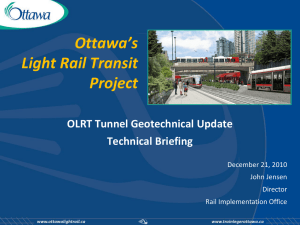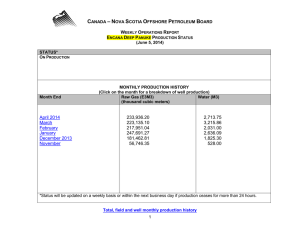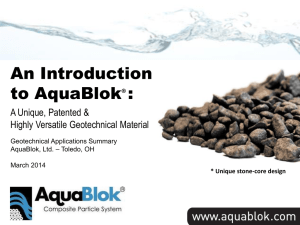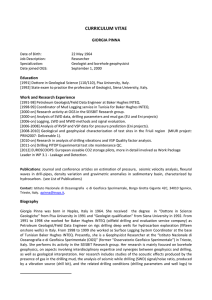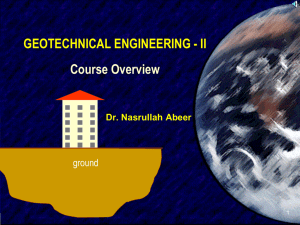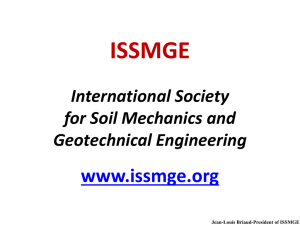Selecting Drilling Methods for the Best Outcome
advertisement
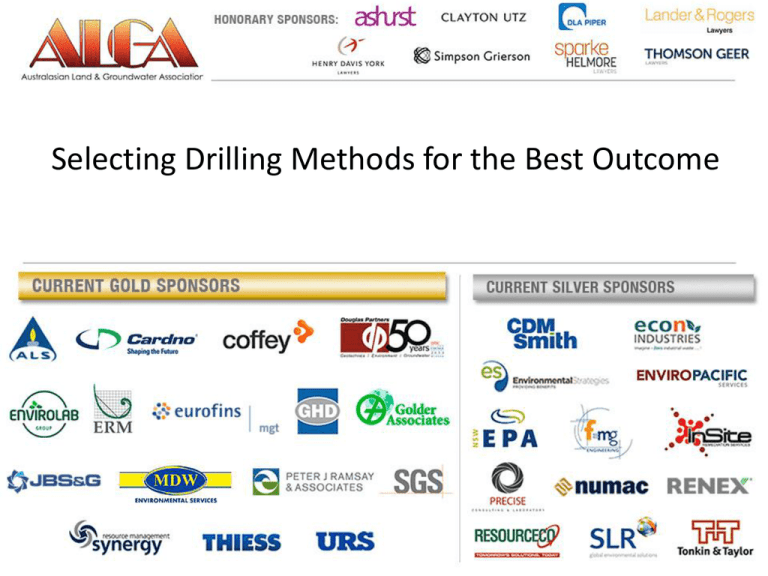
Selecting Drilling Methods for the Best Outcome Selecting Drilling Methods for the Best Outcome Presented by: PUSH PROBE) Terrence Gill (STATS) Mathew Bulmer (MDWES) Peter Grimwood (DIRECT PROPOSED DEVELOPMENT END USE ? • Residential ? • Commercial ? • Industrial ? • Recreational ? • Other ? The end use will govern the depth of investigation required WHERE IS THE PROPOSED DEVELOPMENT ? • CITY CENTRE ? • SUBURBS ? • REGIONAL ? • The loc ation will influence the information that is available WWHAT IS KNOWN ABOUT THE SITE ? WHAT IS THE GEOLOGICAL ENVIRONMENT ? WHAT IS THE SITE HISTORY • IS IT GREEN FIELD? • HAS IT BEEN DEVELOPED BEFORE? YES NO ? Geotechnical /Environmental overlap • Geological maps • Orthophoto maps • Historical Aerial photos • Site History GEOTECHNI CAL ENVIRONMEN TAL CONTAMINATION ? FIND OUT MORE GEOTECHNICAL DESKTOP STUDY ENVIRONMENTAL PRELIMINARY SITE INVESTIGATION P.S.I. WARNING • STAFF AND DRILLERS COULD BE AT RISK • ASBESTOS BEBURIED IN THE GROUND • ORGANIC OR INORGANIC CHEMICALS FOUND • OTHER HEALTH RISKS • P.P.E. MAY BE REQUIRED PLANNING TYPE OF GEOTECHNICAL INVESTIGATION • CATEGORY 1. • • • • SMALL/SIMPLE STRUCTURES LIGHTLY LOADED GROUND CONDITIONS KNOWN FROM EXPERIENCE STABILITY AND SETTLEMENT CALCULATION NOT CONSIDERED NECESSARY • CATEGORY 2. • MEDIUM SIZE STRUCTURES • BRIDGES…RETAINING WALLS…..EMBANKMENTS • CATEGORY 3. • LARGE STRUCTURES • POTENTIALLY DIFFICULT GROUND CONDITIONS PREFERRED TYPE OF SAMPLING REQUIRED Disturbed or Undisturbed • Class 1: Disturbed • Strata identification only • Class 2: Disturbed • Soil Classification tests only • Class 3: Disturbed • • • Soil Classification & water content Class 4: Disturbed or Undisturbed • Soil Classification, water content ,density Class 5: Undisturbed • Soil Classification, water content, density, shear strength, consolidation tests TYPE OF GEOTECHNICAL INVESTIGATION REQUIRED • CATEGORY 1. SHALLOW INVESTIGATIONS • TEST PITS- GENERALLY UP TO 3.0 METERS …… • MAX 5.0 METRES DUE TO LIMITATIONS OF EXCAVATORS EQUIPMENT • ALSO GOVERNED BY THE SUBSURFACE MATERIAL • HAND AUGERS • MACHINE AUGERS • DIRECT PUSH PROBING EQUIPMENT • CLASS OF SAMPLE • Class 1 ,2,3, & 4. • SIZE OF SAMPLE • VARIES ….5KGS FOR P.I.& P.S.D…………UP TO 20KGS FOR MMDD & CBR TYPE OF GEOTECHNICAL INVESTIGATION REQUIRED • CATEGORY 2, & 3 DEEPER INVESTIGATIONS • • • • MACHINE AUGERS DIRECT PUSH PROBE (DPP) & SPT HQ3 DIAMOND CORE & SPT ELECTRIC FRICTION CONE PENETROMETER (CPT) • TYPE OF SAMPLE • DISTURBED • CONTINUOUS • UNDISTURBED OPTIMAL DRILLING SOLUTIONS GEOTECHNICAL • DIRECT PUSH PROBE ( DPP) • CLASS 1 & 2. (Shallow Investigations) • Soil & Soft Rock < 20 Mpa • DPP can add SPT or CPT • • • • CLASS 3 & 4. ( DEEPER Depths) DPP with SPT or CPT (Soil & Soft Rock) Hollow flight auger with SPT (Soil & Soft Rock) Diamond Drilling with SPT ( Soft Rock & Hard Rock) continuous sample for UCS tests • CLASS 5. • Diamond core with SPT ( Soft Rock & Hard Rock) continuous sample for UCS tests Geotechnical /Environmental overlap • SHALLOW INVESTIGATIONS < 5.0 METRES • SMALL SAMPLES REQUIRED FOR BOTH • DPP IDEAL GEOTECHNICAL ENVIRONMENTAL COST EFFECTIVE APPROACH Geotechnical & Environmental Combine Information from Desk Top Study AND P.S.I • HSE issues identified • Acid Sulphate Soils (ASS) addressed • CAN OFTEN Use DPP for both Geotechnical & Environmental investigation and sampling • 1 mob/demob charge • Extend DPP depths and use SPT & CPT for extra Geotechnical design parameters. • Outcome from DPP limited by • hardness of rock and • need for continuous rock coring BENEFITS OF Direct Push Probe (DPP) • CAN BE USED IN BOTH GEOTECHNICAL & ENVIRONMENTAL INVESTIGATIONS • SAVE ON MOB/DEMOB $$ • EXTEND THE DEPTH • DO MORE LOCATIONS • INCLUDE SPT OR CPT • ONE SIZE DOES NOT FIT ALL BUT YOU WILL GET A MORE COST EFFECTIVE RESULT IF YOU CAN PLAN THE GEOTECHNICAL & ENVIRONMENTAL INVESTIGATIONS & SHARE THE SITE TIME. SELECTING DRILLING METHODS FOR THE BEST OUTCOME ENVIRONMENTAL PRACTIONER’S PERSPECTIVE & REQUIREMENTS INVESTIGATION PERCEPTIONS There is a perception that the Geotechnical Investigation is more important than the Environmental Investigation? Why is that ? • They both carry equal importance to understanding the site conditions. • Is Geotechnical data seen to be more commercially viable than environmental data? This leaves the site developer the following scenario • Investigating the site twice which includes: Two mobilisation costs. and Two investigations within the same soil space. WHAT IF? What if both investigations were undertaken at the same time? • Would this impede both investigations? • Could the drill methods be adapted to accommodate both investigation requirements? • Would there be a conflict of interest - two consultancies wanting the same soil sample at the same depth? BACKGROUND DATA UP FRONT If there was one thing we could change it would be to get clients to carry out Preliminary Site Investigation (PSI) at the planning stage up front. Why is this ? • Benefits the Environmental Scientist and Geotechnical Engineer. • Provides the data to develop a Detail Site Investigation (DSI). • Environmental impacts can be assessed and targeted. • Develops a Conceptual Site Model (CSM) for the site. This information at an early stage can be beneficial to geotechnical engineers and all future site investigations including the environmental scientist. PSI INFORMATION IS GOOD INFORMATION The PSI will provide: Historic Land Ownership Historic Maps and Aerial Photos. Land use history – landfills, soil import / export Potential contamination from land use – harmful / toxic Dangerous goods history Acid Sulfate Soils (ASS) risks Geological conditions Hydrogeological conditions - Groundwater depths and local users All of this information helps makes informed decisions about how the site should be investigated and potential control measures required. DEVELOPING A SCOPE OF WORKS TOGETHER Achieving synchronised investigations in an ideal world: • Environmental practioners and geotechnical engineers to collaborate and form partnerships. • Joint development of a site investigation to collect data for both parties. • Reduce any risks to site workers and visitors. • Minimise risk to the environment. • SAVE client time and money in duplicated works. All before the ground is broken on the site! HOW DEEP IS TOO DEEP? Typically environmental investigations are concerned with the upper few metres of the soil profile. Is this enough for the geotechnical engineer? Would drilling depths have to be deeper to accommodate geotechnical requirements? Could the geotechnical engineer sample the soils left? Would soil volumes be sufficient to sample? Does the geotechnical engineer want the same sample depth? Would collaboration at the beginning of the project allow both parties to achieve respective project requirements? ENVIRONMENTAL DRILLING Environmental drilling for sampling purposes is usually undertaken via push probe methodology. This sampling method is selected for: • Clean environmental drilling (no drill fluids). • Soil cores which detail individual soil horizons. • Allows installation of environmental monitoring wells. • Efficient. • The size of the rig allows access onto most sites. PROS If the Environmental Scientist and Geotechnical Engineer investigated together? • Reduced uncertainty in tendering and quoting. • Identify potential site hazards early. • Identify spatial irregularities about site. • Reduce need to remobilise. • Identify opportunities to reduce duplication. • Enhanced focus on chemical properties of upper soil profile. CONS • Conflict of issues in methodology • Sampling depth requirements (Environmental vs Geotechnical) • Potential contamination of samples (drilling method) • Lost billing opportunity: real or perceptive • Who determines objectives • Liability • Perceptions about experience and qualifications SUMMARY Site investigations require the site history, characterisation of physical properties of underlying lithology and vertical profiling of the upper soil profile. Typically this has been achieved via a piece meal process rather than an integrated process. Data from any investigation can serve multiple functions provided the requirements of each function are met. No one method will meet all needs but an integrated approach via early incorporation of a PSI has the potential to save time and money. Specialist GeoEnvironmental Drillers SELECTING DRILLING METHODS FOR THE BEST OUTCOME FOR GEOTECHNICAL OR ENVIRONMENTAL DRILLING Specialist GeoEnvironmental Drillers Geotechnical Drilling Methods Environmental Drilling Methods Desired Outcomes Specialist GeoEnvironmental Drillers GEOTECHNICAL DRILLING METHODS METHOD • DIAMOND DRILLING/TRIPLE TUBE DIAMOND • MUD ROTARY/SONIC • RAB/AIRCORE/RC • DIRECT PUSH/HOLLOW STEM AUGER/CONTINUOUS FLIGHT AUGER DRILLING ADDITIVES • WATER/BENTONITE/POLYMERS/LUBR ICANTS/LOST CIRCULATION MATERIAL • AIR /MUDS/POLYMERS/ LOST CIRCULATION MATERIAL/CONTAINS HYDROCARBONS • MUDS/WATER Specialist GeoEnvironmental Drillers ENVIRONMENTAL DRILLING METHODS COMMON METHODS DRILLING ADDITIVES • DIRECT PUSH • WATER • HOLLOW STEM AUGER/CONTINUOUS FLIGHT AUGER • WATER • SONIC • WATER/MUDS/POLYMERS DESIRED OUTCOMES GEOTECHNICAL • SOIL SAMPLE FOR TESTING • BULK – STRENGTH , MOISTURE ETC • ASS - ANALYSIS • INSITU PARAMETERS • SPT, VANE SHEAR, CPT, SIESMIC, ETC • ADDITIONAL EQUIPMENT DATA LOGGERS • STAND PIPES • GROUND WATER LEVELS, PORE PRESSURES, WATER QUALITY Specialist GeoEnvironmental Drillers DESIRED OUTCOMES ENVIRONMENTAL • SOIL SAMPLE FOR TESTING • CONTAMINATION, ASS, • WATER WELLS – QUALITY, CONTAMINATION, LEVEL • DATA LOGGERS • SOIL VAPOUR READING/WELLS • DIRECT IMAGE – MIP, HPT, EC, ETC Specialist GeoEnvironmental Drillers ONLY WATER WILL DO Specialist GeoEnvironmental Drillers • SOME BENTONITE BASED MUDS AND DRILLING FLUIDS CAN CONTAIN SRB. • SRB – SULPHUR REDUCING BACTERIA • CORROSIVE TO IRON – WELL HEADS AND DOWN HOLE INFRASTRUCTURE • DRILL STRINGS • CAN INTERFERE WITH ASS RESULTS • PRODUCES H2S • WATER WELLS REQUIRE DECONTAMINATION AFTER DRILLING • ALTERS THE CHEMISTRY OF THE WATER • AIR – CONTAINS HYDROCARBONS, SPREADS CONTAMINATION (ASBESTOS, BIOLOGICAL HAZARDS) • OXIDISES AND VOLATILISES • POROUS FORMATIONS WILL ABSORB AIR AND DISCHARGE FOR HOURS SOMETIMES DAYS AFTER DRILLING HAS CEASED • TOOL JOINTS USUALLY LUBRICATED WITH EP GREASE CONTAINING A VARIETY OF ADDITIVES Joint Specialist GeoEnvironmental Drillers CPT & SPT/SOIL BORE/MONITORING WELL JOINT GEOTECH & ENVIRO DRILLING METHODS Specialist GeoEnvironmental Drillers DIRECT PUSH • VARIETY OF DIAMETER SAMPLES - 32MM UP TO 70MM (IDEAL FOR ASS, GEOTECH AND CONTAM SAMPLING) • CAN DO SPT/CPT, VANE SHEAR, DIRECT PUSH, WELL INSTALLATION, HOLLOW STEM AUGER – SAVING TIME AND EXPENSE ON MOBILISING MULTIPLE RIGS • VARIETY OF DIRECT IMAGING APPLICATIONS • ONLY WATER USED IN DRILLING OPERATION – AND THEN ONLY ONCE THE WATER TABLE HAS BEEN REACHED • ALL DIRECT PUSH SAMPLES ARE CONTAINED IN EITHER SPLIT SPOON OR SAMPLE TUBES • RIGS ARE COMPACT AND HIGHLY MOBILE Geotechnical Drilling Methods SPT DIRECT PUSH RIG Specialist GeoEnvironmental Drillers SPT/VIBRATING WIRE PIEZO INSTALLATION/OFF SHORE WORK Joint CPT DIRECT PUSH RIG DIFFICULT SITE ACCESS Specialist GeoEnvironmental Drillers CONCLUSION Specialist GeoEnvironmental Drillers BOTH GEOTECHNICAL AND ENVIRONMENTAL INVESTIGATIONS HAVE THERE OWN STAND ALONE REQUIREMENTS THAT DEMAND THE USE OF SPECIALIST EQUIPMENT . BUT THERE IS THE COMMON GROUND THAT CAN SAVE TIME AND EXPENSE BY COMBINING PARTS OF INVESTIGATIONS WITH THE EFFICIENT USE OF SOME DUAL PURPOSE DRILLING RIGS PANEL SESSION
